Secret Jet Crashes on houses
Secret jet crashes on houses
Three killed by a crashing Westland Wyvern
On Monday 31 October 1949 a semi-secret jet 'plane crashed on council houses in Yeovil killing three people and seriously injuring a fourth.
The aircraft was a paraffin-fueled Westland Wyvern TF.2 prototype Naval strike aircraft. The Wyvern was a single-seat carrier-based multi-role strike aircraft built by Westland Aircraft that served in the 1950s, seeing active service in the 1956 Suez Crisis. Production Wyverns were powered by a turboprop engine driving large and distinctive contra-rotating propellers, and could carry aerial torpedoes. The first flight of a Wyvern was on 16 December 1946 and the later development prototype, the TF.2, first flew on 18 January 1949. The Wyvern entered service in 1953 and was retired in 1958. The TF.2 was on the secret list until April 1949 and at the time of the crash performance and certain other details were still on the secret list.
The following is an amalgamation of several newspaper articles from across the country describing the disaster.
A semi-secret Westland Wyvern turbo-jet fighter prototype crashed on two semi-detached council houses near the Westland aerodrome at Yeovil. The pilot, a six-year old girl cycling on the road and a woman were killed. Another woman, who had been trapped in her blazing house, was rushed to hospital after a dramatic rescue.
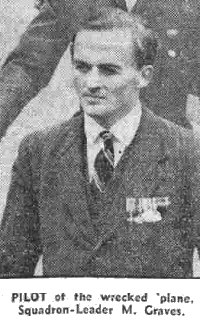 The
pilot was the
Westland
Company's
assistant chief
test pilot
Squadron Leader
Michael Graves
DFC, aged 28,
son of Sir Cecil
Graves, a former
Director General
of the BBC from
1942 until he
retired because
of ill-health in
June 1943.
Squadron Leader
Graves, who had
been with
Westland
Aircraft for two
years, was
attached to the
Middle East
Command and had
received his DFC
in 1942 when he
had a record, as
leader of a
fighter
squadron, of
three enemies
destroyed, five
probably
destroyed, and
many others
damaged. The
body of Squadron
Leader Graves,
who left a widow
and two young
children, was
recovered from
the debris after
Naval men from
Yeovilton Air
Station, in
asbestos
clothing, had
dug away part of
the building and
cut away
sections of the
wrecked fighter.
The
pilot was the
Westland
Company's
assistant chief
test pilot
Squadron Leader
Michael Graves
DFC, aged 28,
son of Sir Cecil
Graves, a former
Director General
of the BBC from
1942 until he
retired because
of ill-health in
June 1943.
Squadron Leader
Graves, who had
been with
Westland
Aircraft for two
years, was
attached to the
Middle East
Command and had
received his DFC
in 1942 when he
had a record, as
leader of a
fighter
squadron, of
three enemies
destroyed, five
probably
destroyed, and
many others
damaged. The
body of Squadron
Leader Graves,
who left a widow
and two young
children, was
recovered from
the debris after
Naval men from
Yeovilton Air
Station, in
asbestos
clothing, had
dug away part of
the building and
cut away
sections of the
wrecked fighter.
The 'plane had been up for about half an hour on a routine test flight when it was seen to dive down out of control. A young apprentice painter, Henry Ford of Milford Lane, who was working on a house nearby, said "I saw the 'plane crashing, leaving behind it in the air a trail of burning fuel about 20 to 30 feet long." It struck the ground and ploughed through perimeter fencing and over 200 yards of waste ground separating rows of dwellings before striking the corner of a block of four houses and catching fire. An eye-witness said that the 'plane seemed to run across the runway "It appeared to blow up as it hit houses at ground level."
Six-year old Anne Wilkins of 8 Westland Road was killed while playing on her bicycle with friends on the waste ground. Her friends scattered as the aircraft approached and escaped harm.
A housewife, Mrs WG Brown, mother of seven children, was buried in the ruins of her home at 30 Westland Road. Her body was recovered by rescue workers after an hour's search. At first it was believed her sister might be buried in the wreckage, but it was later ascertained that she was elsewhere.
A next-door neighbour, Mrs JW Hockey, was trapped by debris between the gas stove and a wall in her badly damaged house. Her clothes were alight when a fire officer rushed into the blazing premises, and a jet of water was played on her while attempts were made to release her. In the meantime, Dr JC McMaster, of Yeovil, who was accompanied by nursing sisters, injected morphia. All the electric power in the area was turned off while civilian and Naval firemen, together with police and neighbours, laboured amid the wreckage and flames. Mrs Hockey was freed about 20 minutes after the crash and taken to Yeovil Hospital. Her condition was stated later that night to be "very critical".
Many thanks to Rob Baker for forwarding the newspaper reports to me.
gallery
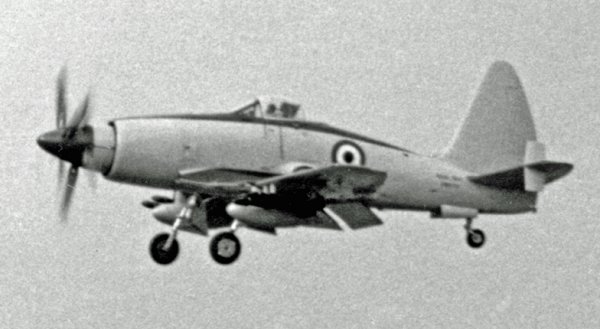
The Westland Wyvern TF.2 prototype Naval strike aircraft.
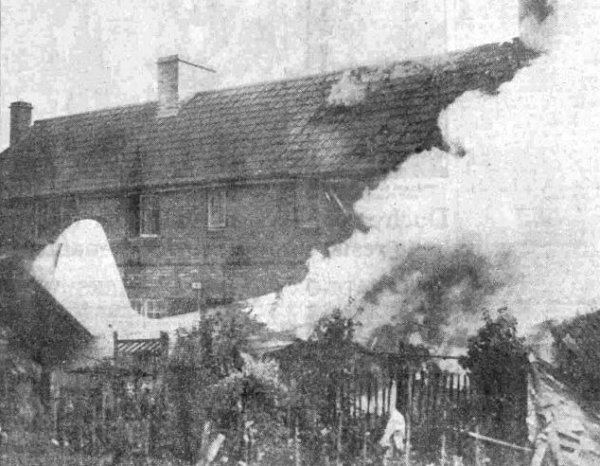
Courtesy of
Roger McElliott
The burning wreck of the Wyvern, from a newspaper photograph.
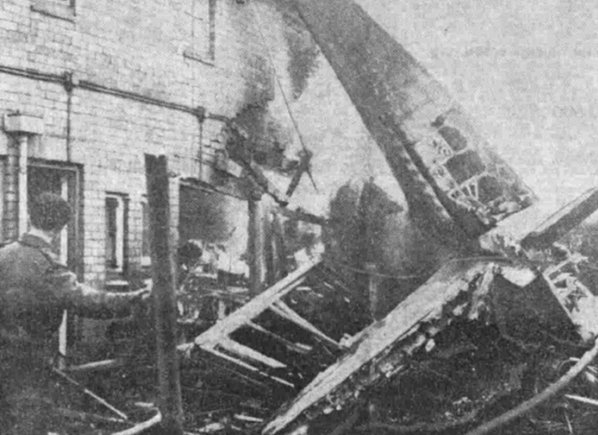
Courtesy of Rob
Baker
The scene of the disaster, photographed in the Western Daily Press 1 November 1949.
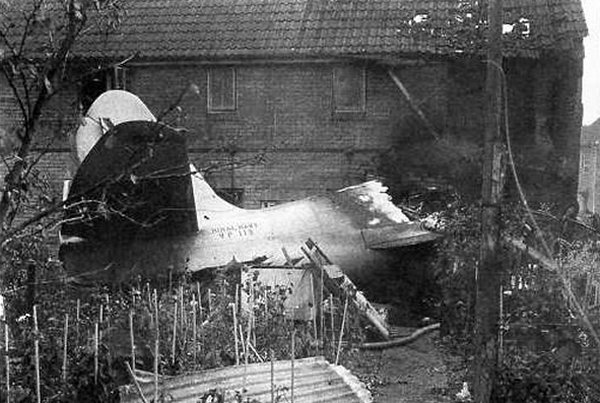
Courtesy of
Roger McElliott
.... and seen from a different angle.
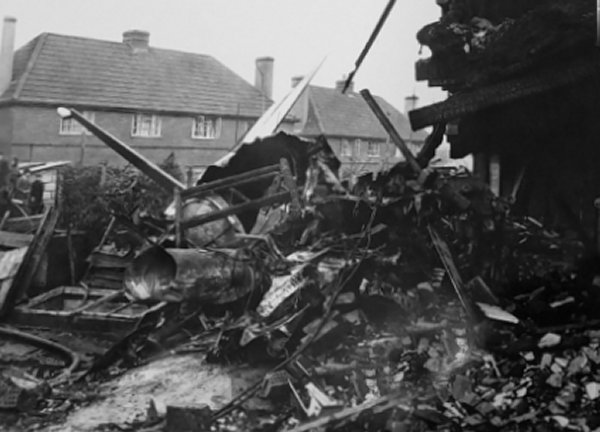
Courtesy of Rob
Baker
Rubble piled up at the scene of the crash.
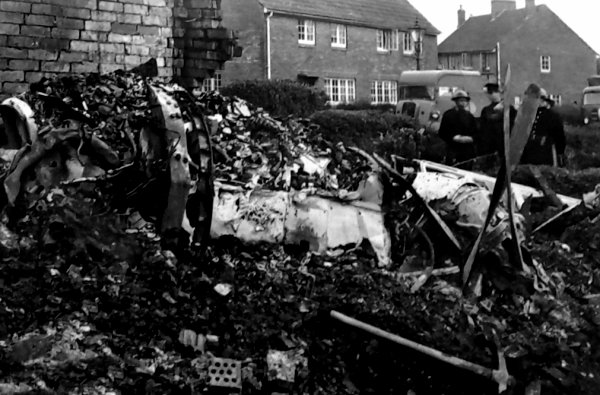
Courtesy of Rob
Baker
Members of the emergency services inspect the destruction.
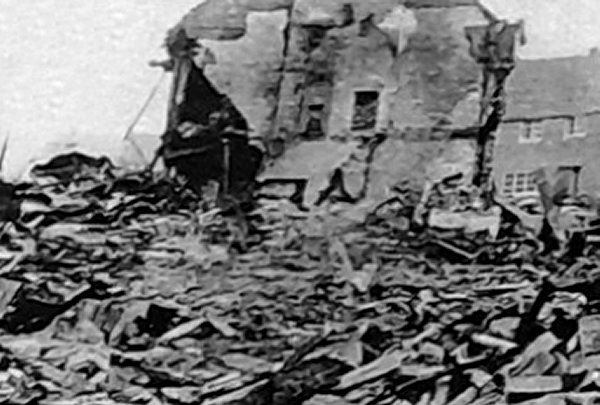
Courtesy of Rob
Baker
The scene of total devastation.